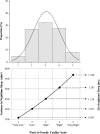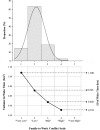Work-Family Conflict and Employee Sleep: Evidence from IT Workers in the Work, Family and Health Study
- PMID: 27568810
- PMCID: PMC5020369
- DOI: 10.5665/sleep.6172
Work-Family Conflict and Employee Sleep: Evidence from IT Workers in the Work, Family and Health Study
Abstract
Study objectives: Work-family conflict is a threat to healthy sleep behaviors among employees. This study aimed to examine how Work-to-Family Conflict (demands from work that interfere with one's family/personal life; WTFC) and Family-to-Work Conflict (demands from family/personal life that interfere with work; FTWC) are associated with several dimensions of sleep among information technology workers.
Methods: Employees at a U.S. IT firm (n = 799) provided self-reports of sleep sufficiency (feeling rested upon waking), sleep quality, and sleep maintenance insomnia symptoms (waking up in the middle of the night or early morning) in the last month. They also provided a week of actigraphy for nighttime sleep duration, napping, sleep timing, and a novel sleep inconsistency measure. Analyses adjusted for work conditions (job demands, decision authority, schedule control, and family-supportive supervisor behavior), and household and sociodemographic characteristics.
Results: Employees who experienced higher WTFC reported less sleep sufficiency, poorer sleep quality, and more insomnia symptoms. Higher WTFC also predicted shorter nighttime sleep duration, greater likelihood of napping, and longer nap duration. Furthermore, higher WTFC was linked to greater inconsistency of nighttime sleep duration and sleep clock times, whereas higher FTWC was associated with more rigidity of sleep timing mostly driven by wake time.
Conclusions: Results highlight the unique associations of WTFC/FTWC with employee sleep independent of other work conditions and household and sociodemographic characteristics. Our novel methodological approach demonstrates differential associations of WTFC and FTWC with inconsistency of sleep timing. Given the strong associations between WTFC and poor sleep, future research should focus on reducing WTFC.
Keywords: family-to-work conflict; inconsistency of sleep clock time; nap; sleep duration; work-to-family conflict.
© 2016 Associated Professional Sleep Societies, LLC.
Figures
Similar articles
-
Better previous night sleep is associated with less next day work-to-family conflict mediated by higher work performance among female nursing home workers.Sleep Health. 2018 Oct;4(5):485-491. doi: 10.1016/j.sleh.2018.07.005. Epub 2018 Aug 16. Sleep Health. 2018. PMID: 30241665
-
The Effects of a Cluster Randomized Controlled Workplace Intervention on Sleep and Work-Family Conflict Outcomes in an Extended Care Setting.Sleep Health. 2016 Dec;2(4):297-308. doi: 10.1016/j.sleh.2016.09.002. Sleep Health. 2016. PMID: 28239635 Free PMC article. Clinical Trial.
-
Age differences in workplace intervention effects on employees' nighttime and daytime sleep.Sleep Health. 2016 Dec;2(4):289-296. doi: 10.1016/j.sleh.2016.08.004. Sleep Health. 2016. PMID: 28105463 Free PMC article. Clinical Trial.
-
Association between insomnia and job stress: a meta-analysis.Sleep Breath. 2018 Dec;22(4):1221-1231. doi: 10.1007/s11325-018-1682-y. Epub 2018 Jun 29. Sleep Breath. 2018. PMID: 29959635 Review.
-
The role of actigraphy in the study of sleep and circadian rhythms.Sleep. 2003 May 1;26(3):342-92. doi: 10.1093/sleep/26.3.342. Sleep. 2003. PMID: 12749557 Review.
Cited by
-
The effects of a workplace intervention on employees' cortisol awakening response.Community Work Fam. 2018;21(2):151-167. doi: 10.1080/13668803.2018.1428172. Epub 2018 Mar 1. Community Work Fam. 2018. PMID: 30078991 Free PMC article.
-
Worse sleep health predicts less frequent breakfast consumption among adolescents in a micro-longitudinal analysis.Int J Behav Nutr Phys Act. 2022 Jun 17;19(1):70. doi: 10.1186/s12966-022-01265-5. Int J Behav Nutr Phys Act. 2022. PMID: 35715858 Free PMC article.
-
Daily stress and sleep associations vary by work schedule: A between- and within-person analysis in nurses.J Sleep Res. 2022 Jun;31(3):e13506. doi: 10.1111/jsr.13506. Epub 2021 Oct 19. J Sleep Res. 2022. PMID: 34668259 Free PMC article.
-
Various Types of Perceived Job Discrimination and Sleep Health Among Working Women: Findings From the Sister Study.Am J Epidemiol. 2020 Oct 1;189(10):1143-1153. doi: 10.1093/aje/kwaa075. Am J Epidemiol. 2020. PMID: 32406503 Free PMC article.
-
Changes in Subjective Motivation and Effort During Sleep Restriction Moderate Interindividual Differences in Attentional Performance in Healthy Young Men.Nat Sci Sleep. 2021 Jul 14;13:1117-1136. doi: 10.2147/NSS.S294409. eCollection 2021. Nat Sci Sleep. 2021. PMID: 34285617 Free PMC article.
References
-
- Hammer LB, Sauter S. Total worker health and work-life stress. J Occup Environ Med. 2013;55:S25–9. - PubMed
-
- Greenhaus JH, Beutell NJ. Sources of conflict between work and family roles. Acad Manag Rev. 1985;10:76–88.
MeSH terms
Grants and funding
LinkOut - more resources
Full Text Sources
Other Literature Sources
Medical
Research Materials



